Page, Durango SRT link 50 years of Mopar
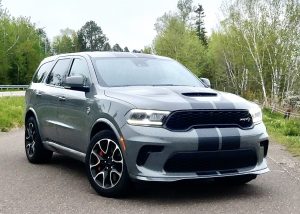
The 2021 Dodge Durango SRT Hellcat packs 702 supercharged horsepower into an SUV that is a throwback to the 1970s muscle cars.
By John Gilbert
The timing was almost perfect, because I had just finished a test-drive week in a 2021 Dodge Durango SRT Hellcat, which is both futuristic and retro, when I got contacted by Wes Eisenschenk, who compiles endless research on finding and writing about Lost Muscle Cars.
The “perfect” part of the timing was because the new Durango SRT comes loaded with all the latest developments that Dodge’s Mopar team, previously known as SRT — for Sports Racing Technology — including a supercharged 6.2-liter monster V8, with 702 Hemi horsepower, right out of the Hellcats, with all-wheel drive added for proper SUV potential. It looks the part of an all-out high-performance monster, and it joins current Charger and Challenger Hellcat models as the closest thing on the streets to a throwback to the 1969-72 era, when Dodge and Plymouth muscle cars were the terror of drag strips. Those included Minnesota Dragways and later Donnybrooke Speedway, which became Brainerd International Raceway.
One of the highlights of my time covering such race tracks for the Minneapolis Tribune was when I made a suggestion to the late Jerry Perkl, the imaginative and hyper-active proprietor of White Bear Dodge, which he turned into the motorsports pinnacle of Dodge dealers. I suggested that with the new “Plum Crazy” color of purple that graced the new Dodges, he should set up a hot-rod Charger for Alan Page, who had become a legendary part of the Vikings “Fearsome Foursome” defensive line for his amazingly quick starts that challenged the referee’s ability to detect whether he had vaulted offside.
Perkl swung into action immediately and got it done. For a proper race, Page needed an opponent, and, because I also covered North Stars hockey, I suggested young defenseman Barry Gibbs. So Perkl pulled his display specialty — a high-winged 1969 Dodge Daytona Charger — off the display and set it up for Gibbs for a Minnesota Dragways exhibition match race.
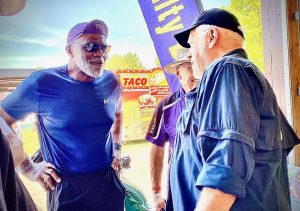
Alan Page talked to John Gilbert at the Mopars in the Park event in Stillwater. — Photo by Jack Gilbert.
Eisenschenk got Page to show up with replicas of those two cars, now privately owned, for an autograph session at the 37th annual “Mopars in the Park” event in mid-June at the Washington County Fairgrounds near Stillwater, Minnesota. In his research, he found a feature I had written in the Minneapolis Tribune archives, and when he finally traced me to Duluth, he was astounded that I had gotten a scoop on the story because I had suggested it in the first place. So he pleaded with me to come down to the event and appear along with Page and the cars. It didn’t take more than an invitation.
The only reason I referred to the idea of the big show being “almost” perfect, incidentally, is that the temperature hit an honest 102 degrees in Stillwater on that June 5 Saturday. It was so hot it also got up- near 100 in Northern Minnesota. The scorching heat was the only flaw in an incredible event. “Mopars in the Park” attracts owners of classic old Dodges and Plymouths, and this year’s event filled acres and acres filled with an estimated 3,000 Mopar hot rods, brightly painted and polished and almost all in the classic, 50-year-old perfection.
Wes had pulled off a coup by locating operational replicas of the original Plum Crazy Dodge Charger and the White Bear Dodge Daytona Charger with the giant rear wing. Perkl reettered the Charger to call it “Vikings Purple.”
Page came out and sat in that sizzling weather for a couple of hours, signing autographs and letting people take hundreds of pictures posing with him, the former Vikings star who then became a Minnesota Supreme Court justice.
The similarity of those 1970-era Chargers and this new version of 21st Century Chargers and Challengers is that the newest Challengers look nearly identical to the vintage ones that never reached this kind of popularity 50 years ago, when competing with Mustangs, Camaros, Barracudas, Firebirds and Javelins in the ponycar marketing battles. But they do have the new high-tech powerplants with the same throaty rumble that might best be described as ground-shaking.
The sophistication of the Hellcat powertrain from the contemporary Chargers and Challengers being stuffed into the Durango SUV is a brilliant move by the fellows from Mopar, which builds the SRT engines, to bring alive a neat large SUV that was just crying out for a dose of hot-rod inspirtion.
The vehicle I had test-driven just before the event came in a special Destroyer Gray, with a wide dual-black stripe running over the roof and all the way down in the front and rear. That, and the other graphics set the SRT Hellcat version apart and above the garden-variety Durangos, which compete well enough with the countless other mid to large SUVs in versatility and utility, but the SRT treatment thrusts the Durango into its own category.
The upgrades to the SRT Hellcat version starts with the engine. It is a 6.2-liter Hemi V8, supercharged to reach 702 horsepower, and the 8-speed automatic is not only heavy-duty but it shifts with amazing smoothness. When you take off hard, you hear the roar of the engine, and then you hear the shift points even though you don’t feel anything as it shifts.
The black interior adds the proper sinister demeanor, and the front bucket seats with suede and leather grip you firmly in a comfortable cocoon. The heavy steering feel is welcome, and the paddle-shift levers are readily operable when you want to manually control your shifting, and if you use them, you must keep using the paddles until such time as you hold the right paddle on for a few seconds, which puts you back into automatic mode.
All imaginable luxury and safety features are included, and everything not included as standard for the $80,995 sticker are added in the option list that boosts the price up to $89,665. That would include blind-spot, lane-departure and adaptive cruise, with rear backup assist monitoring and front collision aid — as well as such classy touches as a suede leather headliner to make you not regret missing out on a sunroof.
Mingling with the vintage Mopars, I was surprised to find that Wes Eisenschenk had enlarged a reprint of my story in the Minneapolis Tribune that told all about the upcoming match race at Minnesota Dragways between Alan Page and Barry Gibbs. A highlight of the sweltering afternoon — thank heaven we were in a building — was my reacquainting with Page. He remembered that I had written about and arranged the details, although he probably didn’t remember that I had also written a few Vikings NFL sidebar stories when he played. Page, of course, looks fantastic and is probably lighter than he was in high school, let alone college or pro.
He also put to rest a story that had become legend, about how the publicity from my stories led the Vikings to demand that he stop drag-racing because of the inherent danger of racing.
“No,” said Page, “nobody from the Vikings ever told me I couldn’t race.”
Come to think of it, Page was so strong-willed, he had several standoffs with the Vikings, such as staying light and in healthy shape to be the quickest defensive lineman in the NFL, when they wanted him to bulk up. So if they had insisted he stop racing, it might have been impossible to pull off.
We had a great conversation about the current Vikings, and I told him I was still writing about all sports, as well as cars, for the Duluth Reader. We also had a good segment about my annoyance that after Case Keenum came off the bench to lead the Vikings to an 11-3 record, the Vikings decided he wasn’t good enough for them and went after Kirk Cousins. I said my feeling was that chemistry was vital to a successful team — much as the Vikings of Page’s time proved — and Keenum gave them the best chemistry they had for decades, with the exception of the Brett Favre years.
“He certainly had an exceptional season with them,” Page acknowledged, diplomatically.
I was thinking it was too bad I wasn’t still driving the SRT Hellcat Durango for that trip, and too bad it wasn’t Plum Crazy, because it would have been the perfect vehicle for Alan Page to drive home as his own.


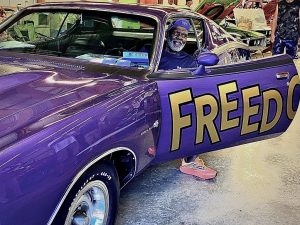
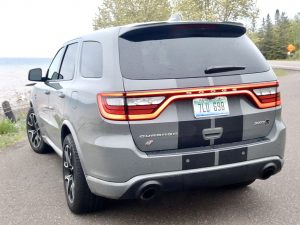

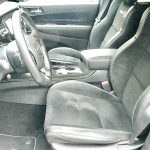
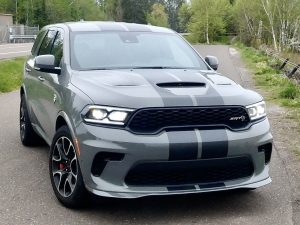
 John Gilbert is a lifetime Minnesotan and career journalist, specializing in cars and sports during and since spending 30 years at the Minneapolis Tribune, now the Star Tribune. More recently, he has continued translating the high-tech world of autos and sharing his passionate insights as a freelance writer/photographer/broadcaster. A member of the prestigious North American Car and Truck of the Year jury since 1993. John can be heard Monday-Friday from 9-11am on 610 KDAL(www.kdal610.com) on the "John Gilbert Show," and writes a column in the Duluth Reader.
John Gilbert is a lifetime Minnesotan and career journalist, specializing in cars and sports during and since spending 30 years at the Minneapolis Tribune, now the Star Tribune. More recently, he has continued translating the high-tech world of autos and sharing his passionate insights as a freelance writer/photographer/broadcaster. A member of the prestigious North American Car and Truck of the Year jury since 1993. John can be heard Monday-Friday from 9-11am on 610 KDAL(www.kdal610.com) on the "John Gilbert Show," and writes a column in the Duluth Reader.